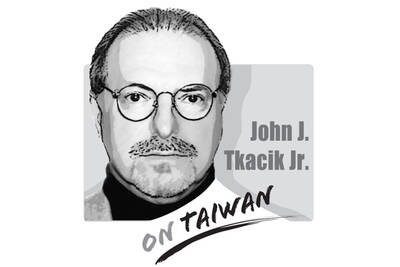In the May 1 issue of the weekly The Economist, Taiwan was the cover story, with the sensational headline “The most dangerous place on Earth.” [One of the issue’s two articles on Taiwan,] which detailed changes in the trilateral relationship between Taiwan, China and the US, caused a stir in Taiwan. Some of the article’s arguments, which focus on China’s growing military strength, make sense, but are not entirely correct.
From the perspective of bilateral interaction alone, it is indisputable that the stronger China’s military is, the greater the threat to Taiwan.
However, cross-strait relations cannot be singled out from the context of international relations. If the possibility of support from other countries were also considered, it could lead to the paradox that the stronger China’s military is, the safer Taiwan would be.
According to the article, Taiwan Semiconductor Manufacturing Co produces 84 percent of the world’s advanced chips, which are crucial to global industrial development. How can other countries just sit back and ignore the situation in the Taiwan Strait? Apart from the US, even France and Germany, which have seldom intervened in East Asian affairs, have launched their own Indo-Pacific strategies to ensure regional stability.
The article said that US Admiral Phil Davidson, head of the Indo-Pacific Command, in March told the US Congress that he worried about China attacking Taiwan as soon as 2027. This comment is rather self-centered.
It is not news that the US Department of Defense has intentionally exaggerated China’s military capabilities to obtain funds from Congress. For example, in the department’s Military and Security Developments Involving the People’s Republic of China report published in September last year, it said that China has 350 warships, surpassing the US’ 293, but it did not mention that China’s fleet is still far below the standard of the US in terms of performance or gross tonnage.
The Indo-Pacific Command is the latest department agency to be restructured, and it is not impossible that the commander deliberately exaggerated China’s intention to use force against Taiwan to show some results.
In addition, The Economist article analyzes only the international situation, but ignores that Chinese concerns over the domestic situation are distracting Beijing from focusing on the Taiwan issue in the near future. The 20th National Congress of the Chinese Communist Party (CCP) is to be held in October next year. Following precedent, past Chinese presidents have served two terms, and Chinese President Xi Jinping (習近平) should have named a successor as party general secretary at the 19th National Congress and appointed that successor to the Standing Committee of the Central Political Bureau and as vice president.
However, no such arrangements were made, indicating that Xi is likely to stay on, which would inevitably create dissatisfaction among CCP factions. Although Xi might choose to use military force against Taiwan to gain domestic support, the significant gap in military strength between the US and China could cause Xi to have to step down early.
It is sometimes said that the most dangerous place is the safest place. Taiwan and the Taiwanese are perhaps best situated to prove this saying: Amid the global COVID-19 pandemic, Taiwan’s performance has been outstanding, and economic growth, and the stock and foreign-exchange markets have reached historical highs. This demonstrates that Taiwanese are full of confidence for the future, and they have no reason to fear alarmist foreign media outlets.
Yang Chung-hsin is a civil servant.
Translated by Lin Lee-kai
A 50-year-old on Wednesday last week died while under anesthesia at a Taipei cosmetic clinic shortly after undergoing a penis enlargement procedure. The surgeon was arrested for suspected medical malpractice, again bringing to the surface shortcomings in the regulation of cosmetic medicine. Media reports said the clinic owner and surgeon, surnamed Ting (丁), was previously convicted of negligent homicide for a postsurgical death and had been charged with coercion and aggravated assault after allegedly stopping a patient from calling for an ambulance. He had also been fined for failing inspections and had allegedly permitted people without medical licenses to assist

It was most annoying last week to read Chairman Xi Jinping’s (習近平) fulsome encomium to the People’s Liberation Army during the Eightieth Anniversary celebrations of victory over Japan in World War II. Comrade Xi’s soaring rhetoric was stuffed with “martyrs, sacrifice, solemnity and unwavering resolve” in praise of the “Chinese People’s War of Resistance Against Japanese Aggression and the World Anti-Fascist War.” His aspirations overflowed with “world peace” and love of the United Nations, of which China is a founding member. The Liberation Army Daily said that every word from General Secretary Xi Jinping “resounded in his powerful voice, illuminating the
An American Institute in Taiwan (AIT) spokesperson on Saturday rebuked a Chinese official for mischaracterizing World War II-era agreements as proving that Taiwan was ceded to China. The US Department of State later affirmed that the AIT remarks reflect Washington’s long-standing position: Taiwan’s political status remains undetermined and should only be resolved peacefully. The US would continue supporting Taiwan against military, economic, legal and diplomatic pressure from China, and opposes any unilateral attempt to alter the “status quo,” particularly through coercion or force, the United Daily News cited the department as saying. The remarks followed Chinese Minister of Foreign Affairs
OpenAI CEO Sam Altman recently sat down for an interview with former Fox News host Tucker Carlson in which he openly acknowledged that ChatGPT’s model behavior is indeed influencing the entire world, and that he himself is responsible for the decisions related to the bot’s moral framework. He said that he has not had a good night of sleep since its launch, as the technology could bring about unpredictable consequences. Although the discussion took place in the US, it is closely related to Taiwan. While Altman worries about the concentration of power, the Chinese Communist Party (CCP) has already weaponized artificial